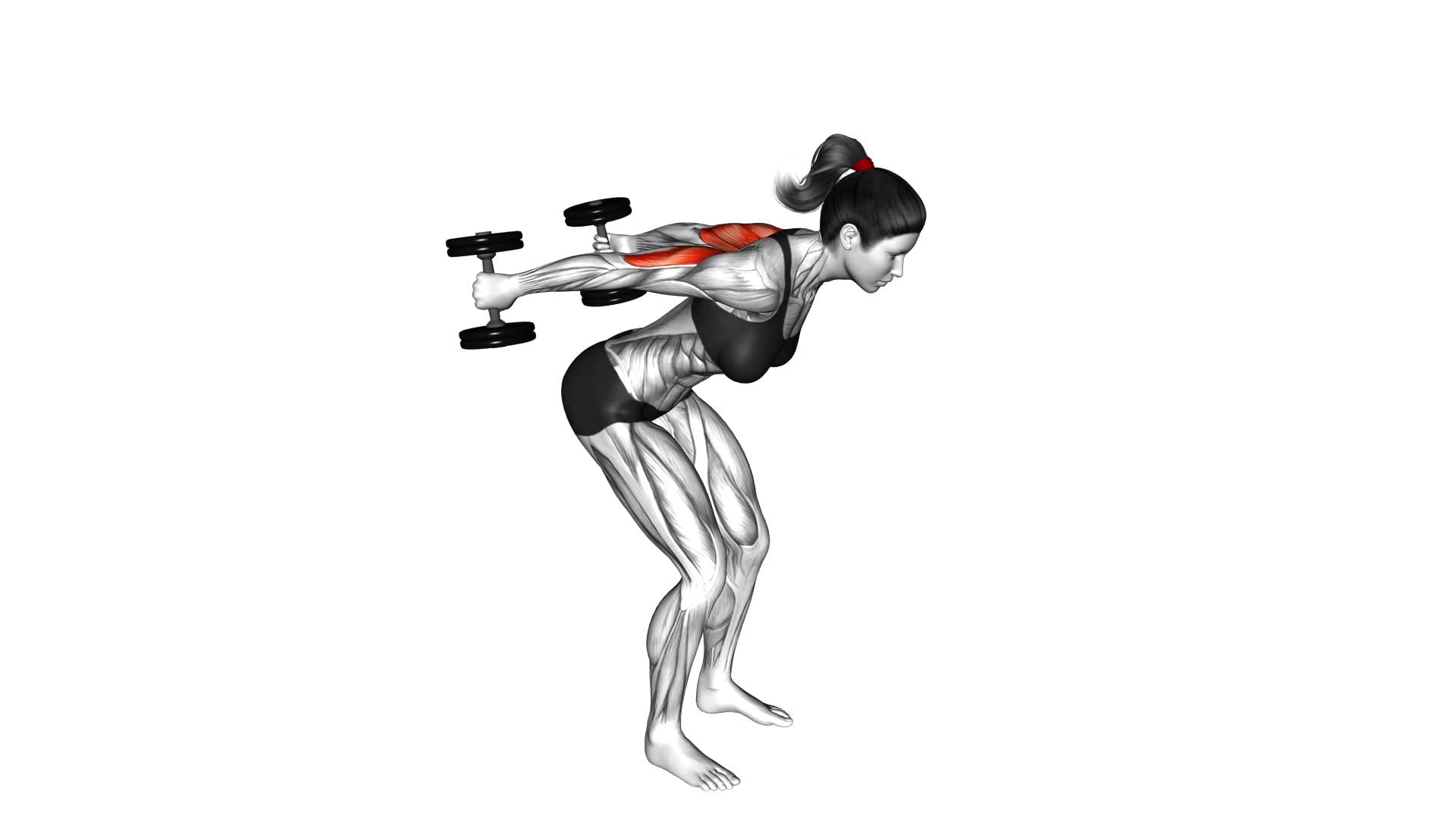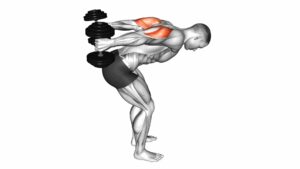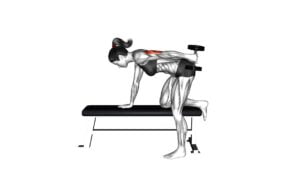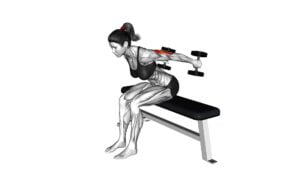Dumbbell Standing Kickback (female) – Video Exercise Guide & Tips

Are you looking to strengthen your triceps and sculpt your arms? Look no further than the dumbbell standing kickback exercise.
Watch This Exercise Video
This video exercise guide and tips will show you the proper form and technique for this effective move. With the right dumbbell weight, you can challenge yourself and avoid common mistakes.
Incorporate the dumbbell standing kickback into your workout routine for toned and defined arms. Let's get started!
Key Takeaways
- The Dumbbell Standing Kickback targets and strengthens glutes, hamstrings, and lower back muscles.
- Incorporating the exercise into a full body workout improves overall strength, coordination, and muscle endurance.
- Proper form and technique, such as avoiding swinging the weight and engaging the core, are crucial for maximizing the benefits and reducing the risk of injuries.
- Choosing the right dumbbell weight that challenges without compromising form and gradually increasing the weight as strength progresses is important for optimal results.
Benefits of the Dumbbell Standing Kickback
You can experience numerous benefits from incorporating the dumbbell standing kickback into your workout routine. This exercise, when performed correctly, targets and strengthens your glutes, hamstrings, and lower back muscles. By engaging these muscle groups, you can improve your overall lower body strength and stability, which can enhance your athletic performance and daily activities.
One of the advantages of the dumbbell standing kickback is its versatility. There are various variations of this exercise that you can incorporate into your routine to keep it challenging and engaging. For instance, you can perform the kickbacks with both legs simultaneously, or alternate between legs to target each side individually. Additionally, you can increase the intensity by using heavier dumbbells or incorporating resistance bands.
Another benefit of the dumbbell standing kickback is that it can be easily integrated into a full body workout. While it primarily targets the lower body, it also engages your core muscles for stability and balance. By incorporating kickbacks into your full body routine, you can improve your overall strength, coordination, and muscle endurance.
Proper Form and Technique for the Exercise
To perform the dumbbell standing kickback exercise with proper form and technique, there are a few common mistakes you should avoid.
One of these mistakes is using too much momentum to swing the weight back, instead of focusing on controlled movements.
Another mistake is hunching or rounding your back, which can put strain on your spine.
Common Mistakes to Avoid
To avoid common mistakes during the dumbbell standing kickback exercise, focus on maintaining proper form and technique. Here are some tips to help you perform the exercise correctly and avoid injuries:
- Full range of motion: Make sure to extend your leg fully, straightening it completely behind you, and then return to the starting position without swinging or using momentum.
- Keep your back straight: Avoid rounding your back during the movement. Engage your core and maintain a neutral spine position throughout.
- Control the weight: Use a weight that challenges you but still allows you to maintain control and proper form. Avoid using excessive weight that compromises your technique.
- Avoid jerking or swinging: Keep the movement slow and controlled. Avoid using momentum or jerking the weight up. Focus on engaging your glutes and using them to lift the weight.
Benefits of Proper Technique
Maintaining proper form and technique in the dumbbell standing kickback exercise enhances the effectiveness of the movement and reduces the risk of injuries. Proper technique is crucial in strength training because it allows you to target the intended muscles and achieve optimal results.
When performing the dumbbell standing kickback, make sure to keep your back straight, engage your core, and avoid swinging the weights. By doing so, you ensure that the focus remains on your triceps and not on other muscle groups. Proper form also helps in maintaining stability and balance throughout the exercise.
By following the correct exercise form, you can maximize the benefits of the dumbbell standing kickback and minimize the risk of strain or injury.
Now, let's move on to the next section and discuss how to choose the right dumbbell weight for your fitness level.
Choosing the Right Dumbbell Weight for Your Fitness Level
When choosing the right dumbbell weight for your fitness level, there are a few key points to consider.
First, it's important to start with a weight that challenges you but still allows you to maintain proper form and technique.
As you progress, gradually increase the weight to continue challenging your muscles and stimulating growth.
Additionally, always listen to your body and avoid using weights that are too heavy, as this can lead to injuries.
Weight Progression Tips
Choose the appropriate dumbbell weight for your fitness level by considering your strength and ability. Here are some weight progression tips to help you select the right weight and advance your training:
- Start Light: Begin with a weight that allows you to perform the exercise with proper form and without straining. It's better to start with a lighter weight and gradually increase as you become stronger.
- Gradual Increases: Once you can comfortably complete the desired number of repetitions with good form, it's time to move up to the next weight increment. Gradually increase the weight to challenge your muscles and promote progress.
- Listen to Your Body: Pay attention to how your body feels during and after each set. If you find the weight is too easy or too challenging, adjust accordingly. Your body will provide valuable feedback to guide your weight selection.
- Aim for Progress, Not Perfection: Don't get discouraged if you can't lift as heavy as someone else. Focus on improving your own strength and gradually increasing the weight over time. Consistency and gradual progress will yield better results in the long run.
Fitness Level Considerations
Are you unsure of what dumbbell weight to choose for your fitness level? When it comes to weightlifting, it's important to choose the right weight that matches your current fitness level.
Selecting a weight that's too heavy can lead to injury, while using a weight that's too light may not provide enough challenge to promote muscle growth. To prevent muscle imbalances and ensure proper form, it's crucial to start with a weight that allows you to complete the exercise with proper technique.
As you progress and become stronger, you can gradually increase the weight to continue challenging your muscles. Remember, it's always better to start with a lighter weight and gradually increase it, rather than risking injury by starting too heavy.
Avoiding Injuries With Weights
To prevent injuries with weights, it's crucial to start with a dumbbell weight that matches your current fitness level. Here are some tips to help you choose the right weight and ensure weightlifting safety:
- Assess your strength: Determine your current strength level by performing exercises with lighter weights. Gradually increase the weight until you find one that challenges you without compromising your form.
- Start with lighter weights: If you're new to weightlifting or returning after a break, it's best to start with lighter dumbbells. This allows your muscles, joints, and tendons to adapt and strengthen over time.
- Focus on proper form: Before adding more weight, make sure you have mastered the correct technique for each exercise. This will help you avoid unnecessary strain on your muscles and joints.
- Listen to your body: Pay attention to any discomfort or pain during your workouts. If you experience any unusual sensations, reduce the weight or seek guidance from a fitness professional.
By following these guidelines, you can minimize the risk of injuries and safely progress in your weightlifting journey.
In the next section, we'll discuss common mistakes to avoid during the dumbbell standing kickback.
Common Mistakes to Avoid During the Dumbbell Standing Kickback
Avoid swinging your arm or using momentum when performing the dumbbell standing kickback exercise. Swinging the arm or using momentum not only reduces the effectiveness of the exercise but also increases the risk of injury. To avoid this mistake, focus on isolating the triceps muscles and maintaining control throughout the movement.
Another common mistake to avoid is using excessive weight. It's important to choose a weight that allows you to perform the exercise with proper form and technique. Using too much weight can lead to compensatory movements and strain on other muscles, increasing the risk of injury. Start with lighter weights and gradually increase the resistance as you become stronger and more comfortable with the exercise.
Additionally, make sure to keep your torso stable and avoid leaning forward or backward during the exercise. This helps to maintain proper alignment and ensures that the triceps muscles are the primary focus of the exercise.
Lastly, be mindful of your breathing. Exhale as you extend your arm and inhale as you return to the starting position. Proper breathing technique helps to stabilize the core and maintain control throughout the movement.
Modifications and Variations to Challenge Yourself
To further challenge yourself, how can you modify or vary the dumbbell standing kickback exercise? Here are four advanced variations and modifications you can try:
- Increase the weight: If you've been using lighter dumbbells, try using heavier ones to increase the resistance and make the exercise more challenging. This will help you build strength and muscle definition in your triceps.
- Single-arm kickback: Instead of performing the exercise with both arms simultaneously, try doing it one arm at a time. This variation allows you to focus on each arm individually and engage your core for stability.
- Resistance band kickback: Attach a resistance band to a stable anchor point and hold the other end with your hand. Perform the kickback movement while keeping tension on the band throughout the exercise. This modification adds an extra resistance challenge and targets the triceps from a different angle.
- Stability ball kickback: Place your chest on a stability ball and perform the kickback exercise while balancing on your toes. This variation engages your core and challenges your stability, making it more difficult to maintain proper form.
Tips for Incorporating the Dumbbell Standing Kickback Into Your Workout Routine
To effectively incorporate the dumbbell standing kickback into your workout routine, start by selecting an appropriate weight and ensuring proper form. Incorporating dumbbells into your routine can help maximize your results by adding resistance to your exercises. When choosing a weight, it's important to select one that challenges you but still allows you to maintain proper form throughout the movement. Too heavy of a weight can lead to poor technique and potential injury, while too light of a weight may not provide enough resistance to effectively target the muscles.
Once you have chosen the right weight, focus on maintaining proper form throughout the exercise. Stand with your feet shoulder-width apart and hold a dumbbell in each hand. Keep your back straight, engage your core, and slightly bend your knees. Start with your arms bent at a 90-degree angle, with your elbows close to your body. From this position, extend your arms straight back, squeezing your triceps at the top of the movement. Avoid swinging your arms or using momentum to lift the weights.
Incorporating the dumbbell standing kickback into your workout routine can help strengthen and tone your triceps. By selecting an appropriate weight and focusing on proper form, you can maximize your results and achieve your fitness goals.
Frequently Asked Questions
Can the Dumbbell Standing Kickback Help With Toning and Shaping the Glutes?
Yes, the dumbbell standing kickback can definitely help with toning and shaping your glutes. By incorporating this exercise into your workout routine, you can target and strengthen the glute muscles.
The benefits of the dumbbell kickback include increased muscle activation in the glutes, improved hip stability, and enhanced overall lower body strength. It's a great exercise to add to your fitness regimen if you're looking to tone and shape your glutes.
How Many Reps and Sets Should I Do When Performing the Dumbbell Standing Kickback Exercise?
When performing the dumbbell standing kickback exercise, it's important to consider the number of reps and sets based on your fitness level. Beginners should start with 2-3 sets of 10-12 reps to build strength and endurance.
As you become more advanced, you can increase the intensity by adding more sets or reps. It's always a good idea to consult with a fitness professional to customize a workout plan that suits your goals and abilities.
Is the Dumbbell Standing Kickback Suitable for Beginners or Is It More Advanced?
The dumbbell standing kickback exercise can be more advanced, but there are beginner modifications available. It's important to start with lighter weights and focus on proper form.
If you find it difficult to balance or maintain control, you can try alternatives such as seated kickbacks or using resistance bands.
As you gain strength and confidence, you can gradually increase the intensity of the exercise. Remember to consult with a fitness professional for personalized guidance.
Can the Dumbbell Standing Kickback Help Improve Overall Strength and Stability?
The dumbbell standing kickback is a great exercise for improving overall strength and stability. By incorporating this exercise into your routine, you can target and strengthen your glutes, hamstrings, and lower back muscles.
This increased strength can help improve your endurance and prevent injuries by providing better support and stability during other exercises and daily activities. Adding the dumbbell standing kickback to your workout routine can be a beneficial step towards achieving your fitness goals.
Are There Any Specific Breathing Techniques I Should Follow While Doing the Dumbbell Standing Kickback Exercise?
When performing the dumbbell standing kickback exercise, it's important to pay attention to your breathing. Proper breathing techniques can enhance the effectiveness of the exercise and provide several benefits.
Conclusion
Incorporating the dumbbell standing kickback into your workout routine can bring numerous benefits. By maintaining proper form and technique, you can effectively target your glutes and hamstrings. Choosing the right dumbbell weight for your fitness level is crucial to ensure a challenging yet safe workout.
Avoid common mistakes such as using momentum or leaning forward excessively. Additionally, consider modifications and variations to continuously challenge yourself.
Follow these tips to maximize the effectiveness of the dumbbell standing kickback in your fitness journey.

Author
Years ago, the spark of my life’s passion ignited in my mind the moment I stepped into the local gym for the first time. The inaugural bead of perspiration, the initial endeavor, the very first surge of endorphins, and a sense of pride that washed over me post-workout marked the beginning of my deep-seated interest in strength sports, fitness, and sports nutrition. This very curiosity blossomed rapidly into a profound fascination, propelling me to earn a Master’s degree in Physical Education from the Academy of Physical Education in Krakow, followed by a Sports Manager diploma from the Jagiellonian University. My journey of growth led me to gain more specialized qualifications, such as being a certified personal trainer with a focus on sports dietetics, a lifeguard, and an instructor for wellness and corrective gymnastics. Theoretical knowledge paired seamlessly with practical experience, reinforcing my belief that the transformation of individuals under my guidance was also a reflection of my personal growth. This belief holds true even today. Each day, I strive to push the boundaries and explore new realms. These realms gently elevate me to greater heights. The unique combination of passion for my field and the continuous quest for growth fuels my drive to break new ground.



